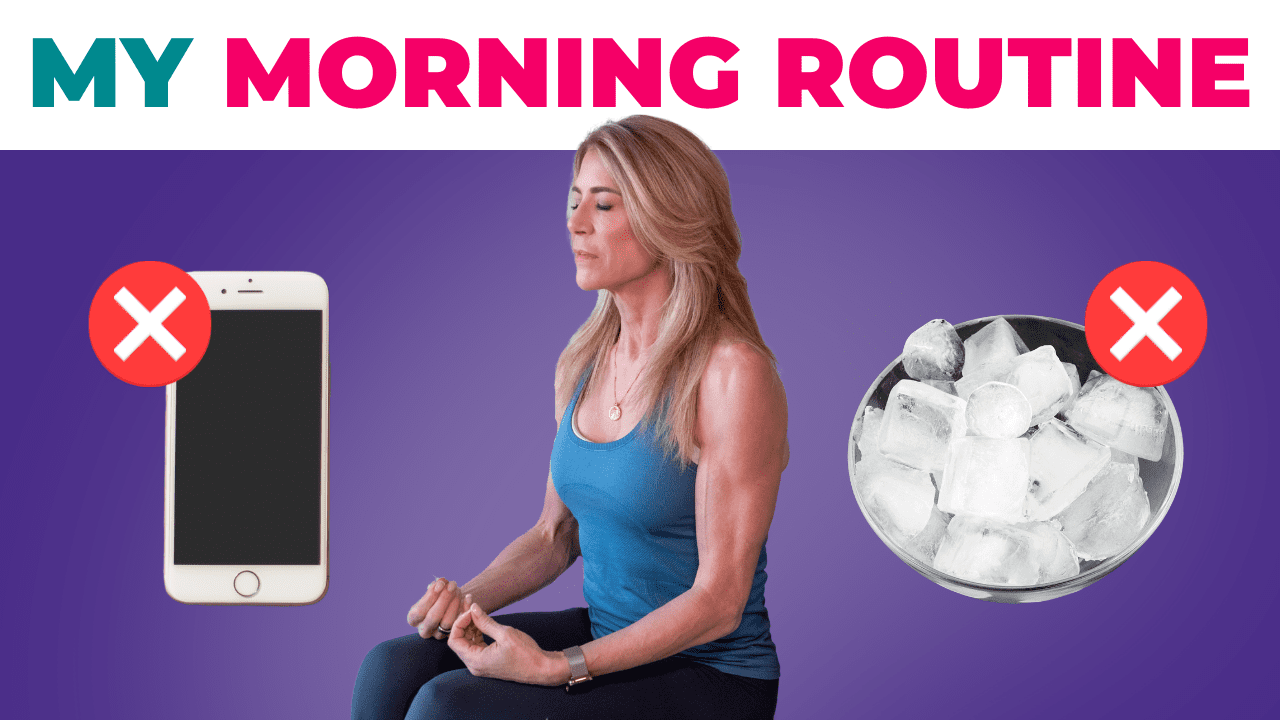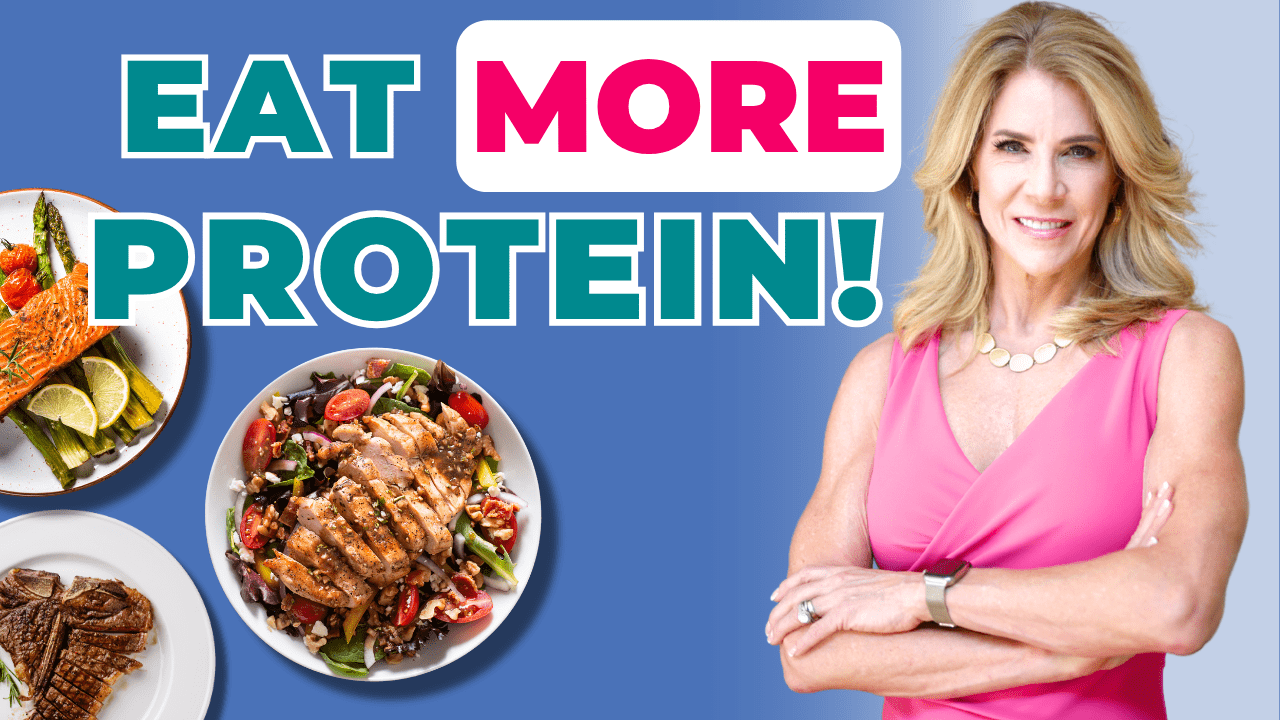7 Tweaks to Tip the Scale in the Right Direction
Seven tweaks, one at a time.
We’ve all been there: You’re working out, you’re eating properly, and for seemingly no reason, the scale stops moving. You’ve hit the dreaded plateau.
Before you go to extreme measures, listen to this episode. In it, I’m giving you seven easy changes to things you’re already doing that you can implement right away to get your metabolism moving and your fat loss fired up. Let’s dive in!
Timestamps
00:01:41 – Keep this in mind before trying any of these tweaks
00:03:06 – Here’s why you should weigh yourself daily
00:04:19 – This one is ridiculously easy
00:06:05 – What is a diet break and why does it help you?
00:07:54 – A word on intermittent fasting
00:09:04 – To improve at exercise, you must do this
00:10:49 – Activity buckets to think about
Resources Mentioned in this episode
Watch the FULL VIDEO on my YouTube Channel
Try my FREE Protein calculator
Read my book, The Sugar Impact Diet
Learn how foods cause leaky gut in The Virgin Diet
Track your protein & macros with Cronometer App
Reignite Wellness™ All-In-One Shakes
Reignite Wellness™ ElectroReplenish
Reignite Wellness™ Amino Power Powder
Listen to What Causes Obesity with Dr. Richard Johnson
Listen to The Hidden Biological Switch That Can Be the Source of Weight & Fat Gain with Dr. Richard Johnson
Study: Journal of Human Kinetics: The Effects of Intermittent Diet Breaks during 25% Energy Restriction on Body Composition and Resting Metabolic Rate in Resistance-Trained Females: A Randomized Controlled Trial
Listen to the Dr. Bill Campbell Episode
Download my FREE resistance training cheat sheet
Video: Nine Foods for Fat Loss You Should Eat Every Day
ATHE_Transcript_Ep 628_Do THIS Daily to Break Through a Weight Loss Plateau
JJ Virgin: [00:00:00] I’m JJ Virgin, PhD dropout, sorry mom, turned four time New York Times best selling author. Yes, I’m a certified nutrition specialist, fitness hall of famer, and I speak at health conferences and trainings around the globe, but I’m driven by my insatiable curiosity and love of science to keep asking questions, digging for answers, and sharing the information I uncover with as many people as I can, and that’s why I created the Well Beyond 40 Podcast. To synthesize and simplify the science of health into actionable strategies to help you thrive.
In each episode, we’ll talk about what’s working in the world of wellness, from personalized nutrition and healing your metabolism to healthy aging and prescriptive fitness. Join me on the journey to better health so you can love how you look and feel right now and have the energy to play full out.[00:01:00]
Nothing is more frustrating on your fitness journey than when you’re gaining momentum, you’re being consistent with your workouts and eating habits, you’re seeing the scale tip in your favor, and then Nothing. You hit a plateau and no matter what you do, it feels like you’re not making any progress. Now weight loss plateaus can happen due to a variety of issues, stress, toxins, a lowered basal metabolic rate due to lowered body weight, poor sleep, change in your hormones, however, The biggest culprits are generally diet and lifestyle.
Now, to break through a plateau, I want you to try these simple tweaks to what you’re already doing. And I’ve included seven, but here’s the thing, just try one at a time, all right? So the first one, if you’re not doing it right now, you got to track your food. That means you got to get a food scale, cups, measuring spoons, and you got to get in there and [00:02:00] really identify what you’re eating.
Remember, too much healthy foods. Unhealthy. And we really tend to underestimate what we’re eating unless we are actively measuring it. And this does not mean you’re going to have to do this all the time. All right. But for now, let’s just make sure that that is not the issue because if you’re eating more calories than your body needs, guess what?
It’s going to store them and likely as fat. So one of the easiest ways to break a plateau is to track your food and really see what’s going on. And along those lines, make sure that when you’re tracking your food, You’re getting the optimal amount of protein for you. I’m going to do a shout out to my free protein calculator at jjvirgin.com/7days, because that is going to help you identify. And that’s a seven number. That’s going to help you identify how much protein you need. So that’s the first part is tracking your food and making sure you’re getting the optimal amount of protein that you need. Over the day and at each meal.
[00:03:00] Next one. You got to be weighing in and I want you to weigh in every single day. I know, I know, but here’s why you’re doing this. First of all, you’re weighing in with a bio impedance scale. You are not using a normal bathroom scale. We got to know what the weight’s made up of because the reality is. It may not be a plateau at all.
What might be happening is that you are dropping fat, putting on muscle. And remember, as you get closer to your goal weight, it is harder and harder to lose that fat, right? There’s just not that much of it. And you’re also wanting to put on muscle. So you’re really trying to make a body composition shift.
Now, when you use a bio impedance scale, it’s going to be based on total body water, this fluctuates. So what I want you to do is do it every single day. Get one of the scales that has a Bluetooth component on your phone. And then you track the average over the week. And then you’ll be able to tell what’s going on.
These bio impedance scales, I correlate it to a DEXA scan. It’s not going to be as accurate as a DEXA, of course, but you are looking for the trends. You want to make sure that the [00:04:00] trend’s going in the right direction. Total body water is going up, which means that your muscle mass, your skeletal muscles going up, and you want your body fat to be going down.
Again, if you lose weight, but you’ve dropped a bunch of skeletal muscle, you just made yourself worse, not better. And it’s going to devastate your metabolism. The next one, this is such an easy one too, is hydration. So you want to be drinking at least to start half your weight in ounces of water. And then you add about one half to one ounce for every minute of exercise.
So if it’s hard exercise, let’s say you go to the gym for an hour and you end up doing about like maybe 30 minutes, maybe 20 minutes of really hard exercise because you’re lifting and recovering. So I’d get in about 30 ounces of water there. Now you want to not just do water. You want to get in some electrolytes as well.
Cause remember, if you’re sweating more, you’re not [00:05:00] losing water. You’re also losing important minerals. So this is where electrolytes come into play. When I go to the gym, I take with me a big old thing of water. It’s a big 64 ouncer that I put my electro replenish. And I put in my amino acid powder in there too.
So I’ve got essential amino acids. I’ve got my electrolytes in there, so I make sure that I stay well hydrated. So that’s another big important one. You know, if you’re just even mildly dehydrated, it’s a stressor to your body. And drinking water also gives your body a little metabolic boost. Now here’s what’s interesting that I learned from Dr.
Rick Johnson. When you are mildly dehydrated, your body can actually take glycogen from the liver and turn it into fructose and store it as fat. Why would this be happening? Well, think of the camels and how the camels store fat so that they can survive extreme dehydration. Burn fat to get liberate the water.
That’s what your body’s doing. It’s sensing a [00:06:00] stressor. It’s making you now hold on to fat and create more fat. So hydration is key. The next one is I’m going to call this caloric variability. But it comes from the research of Dr. Bill Campbell on diet breaks. And that when they look at people who tend to be better at burning fat, better at maintaining healthy habits long term, they do something called diet breaks.
Now, this does not mean that you’re on a diet and then you go crazy on the weekends. This is not that, that fact makes me crazy. I’ll do it this way. Let’s say you do five days where you restrict your calories by like 25%. And then you do two days where you eat what your body normally would be to maintain your weight, and then you repeat it.
What I think of this as is caloric variability. And the reason that I like this, and this is totally a theory, I have no research on this. When I get to sit down with Dr. Bill Campbell, this is what I’m going to ask him about though, is if we chronically lower calories, We know that your body starts [00:07:00] to lower its metabolism too.
Now, some of that could be because your thyroid’s starting to get impaired, but a lot of it may be just because your body weight’s going down. This is why we want to make sure we’re building muscle. But for me, I wonder if we start to get some caloric variability, which is what a diet break can do, could we make it so that your body doesn’t start to do that adaptation?
And so how could we put this into play? Well, one of the easy ways to do this would be to add in a little bit of intermittent fasting. into your Day where like say on the weekends, instead of doing your three meals, you do two meals and you have a late brunch and an early dinner. That way you bop out something, you now have lowered your calories on those days a little bit more, and you’ve got some caloric variability.
So that’s one easy way to do it. And an easy way to do it is to extend your intermittent fasting. Now a word on intermittent fasting. I think that all this fasting has gotten a little bit crazy [00:08:00] because. You should stop eating two to three hours before bed. Three to four is even better. And you should wait at least an hour when you wake up in the morning to eat.
Might say two, three hours, probably better. So for me, I get up in the morning, I eat two hours after I get up, I stop eating three hours before bed. That gives me a natural about 10 hour. Eating window. I think that eating in a 9 12 hour eating window is the way we just normally should be eating. I don’t call that fasting.
So on the weekends, if you could bring it to having brunch at like 11, having an early dinner at 5, boom, you just compressed your eating window a little bit more, did a little intermittent fasting. So that’s an easy way to do it. One thing we just want to make sure of here, and that’s why I bring it up, is you want to make sure you’re stopping eating two to four hours before bed.
And I really like the three to four hours and start eating after an hour of wake up in the morning and go like one to three, see where you’re hungry. Next one, ramp up your workouts. It is so easy to get into a rut. With [00:09:00] exercise, just like it’s easy to get in a rut with diet, but this is an even bigger one because remember the whole thing with exercise is it should be progressive.
In order for you to continue to improve, you’ve got to push yourself farther than what you’re used to, right? So that your body will adapt. So if you’re doing the same stuff. Your body doesn’t have to adapt. So this is where we really need to change things up and ramp up the workouts. For me, we have a place in town that has a HIIT training workout that pushes me far more than I would push myself because I’m super competitive around other people.
So I will go in and do that. With weight training, I started to add in. An extra set on all of my different exercises. So it might be adding in some power moves into your resistance training routine. It might be adding in some sprint interval training into your high intensity interval training. Look at what you can do to take your workups up a notch, right?
Now, I also have my [00:10:00] free eight week training program at jjvirgin.com/power. If you’re like going, I just need to start doing resistance training. There you go, I’ve got you hooked. Now, I talked about resistance training and adding in some things, and when you think about that, I want you to look at, what could I add in new as well?
So if you are not doing resistance training, that’s the easy one. Let’s say that you’ve been doing a lot of resistance training, and you’re walking, but maybe you would need to add in some high intensity interval training. And again, I was doing it at home, but I was nowhere pushing myself as much as when I went to this class that was a high intensity interval training, power training class.
So look at some opportunities for you to go out there and try new different things, because in order for you to get what you really want from exercise. You got to keep changing it up. There’s one other thing too, cause we think about exercise and I kind of have a bucket. We have activity and within activity, we have something called non exercise activity [00:11:00] thermogenesis.
And this is a combination of a couple of things. Number one, are things you’re not even aware of, how much you fidget, how much you move around that’s subconscious. But then there’s an also a piece to this of just. Can you stand up more than you sit down? Could you get a walking treadmill? So when you’re on conference calls, you could be walking on that treadmill.
Can you add in a walk after your meals? How can we add more activity into your day? Because actually we tend to think of exercise. And how mission critical it is. But a lot of times that will only be about 5 percent of your activity throughout the day. Now, granted what is doing to your muscles and how it’s creating oxygen debt has a bigger metabolic effect after, but what we do want to think about is this NEAT or non exercise activity thermogenesis.
Both from things that we don’t really think about, right, like fidgeting, and from things that you can actively do, like taking the stairs, parking farther away, can account for 5 to 15 percent of your daily activity. It can make a [00:12:00] big, big, big difference. I remember I went to UCLA as an undergrad and I got a moped when I was a junior.
Prior to that, UCLA is a massive campus. And I lived up in a dorm that was all the way up these stairs. And the minute I got a moped was the minute I started to have to add in a lot more exercise and start to focus on what I needed to do to maintain my weight because I started gaining weight because I pushed out all of that regular activity that my body just come to know and like.
So let’s look at how you can just add more of that in because it all matters. So again, I just gave you a bunch of different ones. Pick one. Think about all those and go, Oh, I’m doing that. Oh, this could be a great help. It might be as simple as saying. I’m going to start walking after one meal a day. Do something that can start to become a habit, and then once you’ve done that one, let’s go to the next one.
Now you know what to do here. You’re going to need to know what to eat. [00:13:00] So to set yourself up for success and get back on the fast track to fat loss, I’ve got a video for you on the nine foods that you should eat every day to reach your body composition goals. Be sure to join me next time for more tools, tips, and techniques you can incorporate into everyday life to ensure you look and feel great, and more importantly, that you’re built to last.
And check me out on Instagram, Facebook, YouTube. And my website, jjvirgin.com. And make sure to follow my podcast so you don’t miss a single episode at subscribetojj.com. See you next time.
Hide Transcript

 Subscribe to our show
Subscribe to our show 





